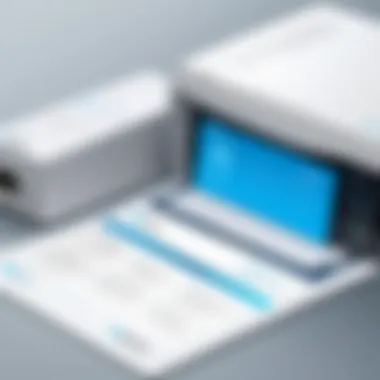Exploring the Benefits of OpenText Fax Server for Businesses


Intro
In an increasingly digital world, traditional communication methods continue to hold significance. One such method is faxing. Despite the rise of email and instant messaging, many organizations rely on fax, especially in industries that require secure document transmission. OpenText Fax Server stands as a leading solution, addressing the needs of modern businesses while retaining the effectiveness of traditional faxing. This article will delve into the key features, architecture, integration abilities, advantages, and considerations for using OpenText Fax Server.
Key Features
Overview of Features
OpenText Fax Server offers a suite of functionalities designed for efficiency and security. Notable features include:
- High Volume Processing: Able to handle thousands of faxes simultaneously, crucial for larger businesses.
- Secure Transmission: Data encryption ensures sensitive information remains confidential during transmission.
- User-Friendly Interface: A simple web-based interface facilitates easy access for users.
- Automated Workflows: Integration with existing systems streamlines faxing processes.
- Reporting and Analytics: Users can track fax activity, offering insights into operational efficiency.
These features make OpenText Fax Server not just a tool, but an integral part of an organization’s communication strategy.
Unique Selling Points
What sets OpenText Fax Server apart from other fax solutions? Its unique selling points include:
- Scalability: The server can grow with a business's needs, accommodating increasing faxing volume.
- Integration Capabilities: Seamlessly connects with platforms like Microsoft Dynamics and Salesforce, enhancing usability.
- Compliance Framework: Meets industry regulations, making it suitable for sectors that prioritize privacy, like healthcare and finance.
- Cost Efficiency: Reduces operational costs through automation—less time spent on manual faxing.
Organizations looking for a reliable, scalable solution will find strong value in OpenText Fax Server.
Pricing Structure
Tiered Pricing Plans
OpenText Fax Server offers tiered pricing plans that cater to a range of business sizes and needs. Each plan provides varying levels of features:
- Basic Plan: Ideal for small businesses; focuses on essential faxing capabilities.
- Professional Plan: Aimed at medium-sized organizations looking for advanced features and integration.
- Enterprise Plan: Tailored for large enterprises requiring robust functionalities and user support.
The structure allows businesses to select a plan that aligns with their operational requirements and budget.
Features by Plan
Each pricing plan includes distinct features that cater to different user needs:
- Basic Plan Features: Standard faxing; basic security measures.
- Professional Plan Features: Enhanced security options, reporting tools, and integrations.
- Enterprise Plan Features: Comprehensive automation, dedicated support, advanced compliance features.
Selecting the appropriate plan is vital for maximizing the benefits of the OpenText Fax Server.
"OpenText Fax Server combines traditional fax functionality with modern technology, providing a valuable resource for any organization's communication needs."
This exploration aims to guide organizations in their consideration of OpenText Fax Server as a pivotal component in their communication framework.
Foreword to OpenText Fax Server
In an era where digital communication is paramount, many might overlook established methods such as faxing. OpenText Fax Server emerges as a pivotal solution for organizations seeking to integrate fax capabilities within their digital workflow. Understanding OpenText Fax Server extends beyond mere functionality; it involves recognizing its role in optimizing communication processes within businesses.
This platform presents a comprehensive approach to faxing, encompassing automation and security. The significance of fax technology does not diminish despite the rise of email and instant messaging. In fact, many industries still rely heavily on fax due to its compliance and security advantages, particularly in sectors like healthcare, finance, and legal services.
OpenText Fax Server provides organizations with essential tools to manage fax communications efficiently. It reduces paper usage, streamlines processes, and ensures that sensitive information is transmitted securely. The integration of this technology into business operations results in improved productivity, which is crucial in today’s competitive landscape.
By exploring the features and capabilities of OpenText Fax Server, decision-makers can make informed choices about their communication infrastructure. This examination allows organizations to assess how faxing solutions can fit into their broader IT strategy.
Understand that choosing the right fax server solution is not just a technical decision; it is also a strategic one that can influence an organization’s operational efficiency.
As we delve deeper into the components of OpenText Fax Server, it becomes clear that its offerings extend well beyond traditional fax solutions. The following sections will uncover its core features, architectural considerations, and the advantages derived from choosing this technology.
Core Features of OpenText Fax Server
OpenText Fax Server stands as a critical solution for organizations requiring reliable fax communication. In the digital age, the ability to automate and streamline fax processes enhances business operations significantly. Here, we will explore the core features that define OpenText Fax Server, emphasizing their relevance and impact on efficiency.


Automated Fax Processing
Automated fax processing is a cornerstone feature of OpenText Fax Server. This capability allows organizations to send and receive faxes without manual intervention, reducing the potential for human error. Users can configure the server to automatically process incoming faxes, categorize them, and route them to designated electronic mailboxes or document management systems.
Benefits of automated fax processing include:
- Efficiency: Streamlining workflows cuts down on the time needed for fax tasks.
- Resource Allocation: Staff can focus on higher priority tasks rather than managing fax operations.
- Traceability: Each fax can be tracked for compliance and auditing purposes.
Automation reduces the dependence on physical fax machines, enhancing workplace productivity.
User Interface Overview
The user interface of OpenText Fax Server is designed to ensure accessibility and ease of use for its diverse user base. It offers an intuitive dashboard where users can manage their fax jobs, configure settings, and access past transmissions quickly. The layout prioritizes clarity, which helps even non-technical users navigate without steep learning curves.
Key elements of the user interface include:
- Dashboard: Real-time status of fax jobs is visible on a clear dashboard.
- Alerts: Users receive notifications about incoming faxes or any issues that may arise.
- Custom Settings: Users can tailor their preferences to suit specific needs.
This focus on user experience is crucial in ensuring effective usage in busy business environments.
Reporting and Analytics
Reporting and analytics within OpenText Fax Server provide organizations with insights into their fax activities. Businesses can generate reports that outline usage patterns, delivery success rates, and operational efficiencies. This data can be pivotal in understanding communication flows and identifying areas for improvement.
Benefits of robust reporting include:
- Performance Metrics: Allows decision-makers to measure the effectiveness of their fax operations.
- Operational Insights: Helps in pinpointing bottlenecks or inefficiencies within the fax process.
- Strategic Planning: Data derived from usage can inform future investments and technology upgrades.
Utilizing reporting features transforms fax management from a conventional task into a strategic enterprise activity.
Overall, the core features of OpenText Fax Server underscore its critical role in modern digital communications, supporting organizations to enhance their operational capabilities.
Understanding the Architecture of OpenText Fax Server
The architecture of OpenText Fax Server is crucial to its effective operation and integration within an organization’s existing infrastructure. A solid understanding of this architecture allows decision-makers to align their operational needs with the capabilities of the system. This knowledge fosters informed choices when deploying fax services, ultimately enhancing overall communication strategies.
System Requirements
For successful deployment, OpenText Fax Server has specific system requirements. These requirements typically include the necessary hardware specifications, operating system compatibility, and network capability. Organizations should ensure that the server is provisioned with adequate memory, processing power, and storage capacity. Up-to-date operating systems, like Windows Server versions, are commonly utilized. The requirement of a stable internet connection is also vital for cloud features.
Deployment Models
The deployment models of OpenText Fax Server offer flexibility for various business environments. Each model has distinct characteristics that make it suitable for different organizations. The three primary deployment options are detailed below:
On-Premises Deployment
On-Premises Deployment refers to installing the OpenText Fax Server within the organization’s internal network. This setup allows for greater control over data and resources. One key characteristic of this model is the independence from third-party service providers. This can be beneficial for organizations that prioritize data security and compliance. However, it requires internally managed infrastructure, which can lead to higher costs in maintenance and upgrades.
Cloud-Based Deployment
Cloud-Based Deployment utilizes remote servers managed by a service provider. In this model, organizations can access the fax server through the internet, which reduces the infrastructure overhead. The main characteristic of Cloud-Based Deployment is its scalability; it allows businesses to adjust resources based on demand easily. This model can also lower initial investment costs. However, it does rely on a strong internet connection, and some companies may have concerns about data security when using shared servers.
Hybrid Solutions
Hybrid Solutions combine elements of both On-Premises and Cloud-Based Deployment. This flexibility enables organizations to maintain some critical data and operations internally while utilizing cloud capabilities for scalability and redundancy. The significant characteristic of Hybrid Solutions is their adaptability to varied needs. Businesses that face fluctuating workloads often find this model beneficial. However, managing such a hybrid setup can introduce additional complexity; organizations need to ensure seamless integration between both environments.
Integration Capabilities
Integration capabilities are critical for any fax server solution. They enable streamlined communication processes, ensuring that faxing becomes a seamless part of existing workflows. OpenText Fax Server excels in this area, allowing organizations to easily incorporate fax functionalities into their operational framework.
Compatibility with Existing Systems


The capability of OpenText Fax Server to interact with existing systems is a vital aspect of its integration framework. Businesses often rely on various software and tools for their daily operations. OpenText offers compatibility with a range of enterprise applications, including CRM systems like Salesforce and ERP systems such as SAP. This compatibility allows users to send and receive faxes directly from these platforms without leaving the interface they are accustomed to.
Having a high level of compatibility reduces disruption during the implementation phase. Users can maintain their current workflow while enhancing it with added fax capabilities. Moreover, this integration supports the automation of processes, reducing manual inputs and errors often associated with traditional faxing methods. Again, this leads to increased efficiency and productivity.
APIs and Connectivity Options
OpenText Fax Server provides a robust set of APIs that enhance its connectivity options. These APIs serve as building blocks for developers who seek to implement customized fax solutions within their applications. By utilizing these APIs, businesses can automate faxing services, manage workflows, and track communications more effectively.
One significant advantage of these connectivity options is the ability to integrate with cloud-based applications. This means that businesses can leverage OpenText Fax Server's capabilities without requiring extensive on-premises infrastructure. Instead, cloud solutions provide agility and flexibility, allowing organizations to adapt to changing business needs.
By taking advantage of these APIs, companies can also improve data integrity. Information exchanged via faxes can be automatically logged and stored, allowing for better tracking and retrieval processes. This is especially beneficial for audits or compliance requirements, where maintaining accurate records is crucial.
"Integration capabilities empower organizations by enhancing productivity while ensuring a seamless flow of information."
In summary, the integration capabilities of OpenText Fax Server are essential for modern businesses looking to optimize their communication strategies. Ensuring compatibility with existing systems as well as providing versatile APIs allows companies to leverage faxing technology effectively.
Advantages of Using OpenText Fax Server
OpenText Fax Server is more than just a tool for sending and receiving faxes. It offers several key advantages that significantly benefit organizations. Whether it is about lowering costs, enhancing security, or improving workflow, these advantages deserve a closer look.
Cost Efficiency
Implementing OpenText Fax Server can lead to substantial cost savings. Traditional faxing often incurs various expenses, such as paper, ink, and dedicated phone lines. OpenText Fax Server reduces these costs by allowing digital faxing. Organizations can send and receive faxes directly through their network without the need for physical resources.
Moreover, the automated fax processing capabilities eliminate the manual labor associated with traditional faxing. This means that staff can focus on more strategic tasks rather than dealing with paperwork. The overall reduction in operational costs makes this solution attractive for businesses.
Enhanced Security Features
Security is a paramount concern for businesses today. OpenText Fax Server integrates robust security measures that protect sensitive data. Unlike traditional fax machines, which can leave faxes unattended or vulnerable to unauthorized access, OpenText Fax Server encrypts documents in transit.
- Access controls ensure that only authorized personnel can send or receive faxes.
- Audit trails maintain records of fax transactions, promoting accountability.
- Compliance with regulatory standards such as HIPAA is easier to achieve with this digital solution.
This level of security is essential for businesses that deal with confidential information.
Improved Workflow Automation
Workflow efficiency is critical in a fast-paced business environment. OpenText Fax Server streamlines fax operations by integrating with existing applications. This means users can send faxes directly from software they already use, such as email clients and document management systems.
Additionally, features like bulk faxing and scheduled delivery enhance productivity. Automated notifications alert users when a fax has been sent or received, ensuring they are kept informed without constant monitoring.
"By integrating fax capabilities into workflows, businesses can significantly reduce turnaround times and enhance service delivery."
Each of these advantages serves to improve the overall functionality of an organization, making OpenText Fax Server a viable option in today's digital workplace.
Considerations and Challenges
When organizations consider implementing OpenText Fax Server, it is crucial to recognize both the advantages and challenges that can arise. Understanding these barriers helps in crafting a more effective implementation strategy, ensuring that the technology not only meets current needs but also adapts to future changes. These considerations include the complexities surrounding implementation and the ability of users to adapt.
Implementation Barriers
Implementation of the OpenText Fax Server can often face hurdles that may delay or even derail projects. Common barriers include:
- Infrastructural Limitations: The existing IT infrastructure may not support new software installations without modifications. Upgrades to servers or network configurations could be necessary.
- Integration Complexity: OpenText needs to connect seamlessly with existing systems such as ERP and CRM. Custom integrations can be resource-intensive.
- Compliance Requirements: Regulatory standards, especially in industries like healthcare or finance, may introduce additional compliance requirements that need to be addressed.
- Resource Allocation: Allocating sufficient resources including time, personnel, and finances is crucial. Companies may underestimate the effort needed.
Across various implementations, it is clear that bypassing these barriers is key to achieving a successful rollout and long-term sustainability of the fax solution.
User Adoption Challenges
Once the technology is in place, user adoption presents another set of challenges. Even with a robust system, if users are not comfortable, the effectiveness of the OpenText Fax Server diminishes. Some challenges in this area include:
- Resistance to Change: Users familiar with traditional fax methods may resist adopting new technology. Effective change management strategies can be vital in overcoming this.
- Training and Support: Proper training programs are essential to ensure that users understand the capabilities and functionalities of the fax server. Lack of training can lead to frustration and errors.
- Perceived Complexity: If users find the interface too complex, they may revert to familiar methods, undermining the new system's benefits.
- Technical Support: Continuous access to technical support can alleviate concerns users have about operating new software, fostering greater confidence in using the system.


Ultimately, addressing these challenges head-on allows organizations to optimize the benefits of OpenText Fax Server, ensuring smoother workflows and higher satisfaction rates.
"Anticipating challenges is half the battle; tackling them effectively defines the success of the implementation."
Planning, training, and engagement with users are essential components in minimizing these obstacles.
Real-World Applications
The relevance of OpenText Fax Server becomes particularly evident when examining its practical applications across various sectors. As businesses increasingly navigate a digital landscape, understanding how fax technology integrates into day-to-day operations is crucial. This section focuses on specific cases and user experiences that illuminate the advantages and adaptability of OpenText Fax Server in real-world scenarios.
Case Studies in Diverse Industries
OpenText Fax Server’s versatility is noteworthy, as it caters to different industries with unique operational challenges. Let’s look at a few examples:
- Healthcare Providers: Medical institutions often handle sensitive patient information that requires secure transmission. By using OpenText Fax Server, a hospital could streamline communication with insurance providers while ensuring compliance with regulations like HIPAA. Reports indicated a decrease in processing time for claims, leading to improved cash flow.
- Financial Services: A prominent bank implemented OpenText Fax Server to manage customer account applications. The automated processes helped reduce the manual workload by 30%. With secure faxing, the bank ensured confidentiality and integrity of sensitive financial data.
- Legal Firms: A law firm integrated OpenText Fax Server for sending and receiving legal documents. The ability to manage faxes directly from email ensured that deadlines were met more efficiently. This integration resulted in an increase in productivity as less time was spent on document management.
These examples demonstrate that various industries can leverage OpenText Fax Server’s strengths. By facilitating secure, compliant, and efficient communication, organizations enhance their operational effectiveness.
User Testimonials and Experiences
Understanding how actual users perceive and interact with OpenText Fax Server offers valuable insight into its day-to-day functionality. Here are some highlights from user experiences:
- Increased Productivity: A project manager at a manufacturing firm shared that the automated fax processes eliminated repetitive tasks, allowing team members to focus on core activities. This was particularly evident when handling order confirmations and supply-chain communications.
- User-Friendly Interface: An IT administrator praised the intuitive user interface of OpenText Fax Server, emphasizing that training new employees took significantly less time than with previous systems. The simplicity promoted user adoption across the organization.
- Reliability: Users often highlight the reliability of OpenText Fax Server during critical business operations. A representative from a non-profit organization noted that their fax communications were crucial during fundraising campaigns. The server�’s uptime assured them that important documents were transmitted without delays.
"OpenText Fax Server transformed our communication workflow. It is a vital component of our operations that we cannot do without."
– Operations Manager, Technology Firm
In summary, the real-world applications of OpenText Fax Server in different industries reveal a common theme: efficiency. The direct feedback from users underscores its importance in improving workflows, ensuring security, and supporting organizational goals.
Future Developments in Fax Technology
Understanding the future developments in fax technology is crucial for businesses looking to adapt to evolving communication needs. The integration of new technologies into the traditional fax system enables organizations to enhance operational efficiency, security, and flexibility. As companies increasingly adopt digital methods, recognizing these developments allows for informed decision-making in implementing fax solutions.
Trends and Innovations
Recent trends demonstrate a clear shift towards automation and cloud-based solutions within fax technology. Companies are increasingly adopting these systems due to several benefits.
- Cloud Integration: Many organizations are moving fax services to the cloud. This shift improves accessibility and reduces the need for on-site infrastructure.
- Mobile Solutions: The rise of mobile applications allows users to send and receive faxes from smartphones. This convenience is crucial in the modern workplace where mobility is essential.
- Enhanced Security Features: With stricter regulations surrounding data privacy, fax services are prioritizing security. Innovations include end-to-end encryption and two-factor authentication, addressing concerns about data breaches.
- AI-Based Automation: Artificial intelligence is being employed to facilitate automated fax processing. This reduces manual errors and accelerates workflow, allowing teams to focus on more strategic tasks.
These trends not only enhance efficiency but also position fax technology as an integral component of the broader digital transformation within organizations.
The Digital Transformation of Fax Communications
The digital transformation of fax communications signifies a revolutionary shift in how businesses operate. This transformation emphasizes the importance of seamless integration between traditional methods and modern practices.
- Interoperability: Future fax solutions prioritize interoperability with other communication systems. This allows businesses to send faxes from various platforms without limitations.
- Increased Collaboration: Enhanced features enable better collaboration among teams. Users can attach files directly from cloud storage services and track documents in real time.
- Reduced Environmental Impact: Digital faxing significantly reduces paper usage, aligning with the growing commitment to sustainability in corporate practices.
"Adopting digital fax technology can add significant value to organizational workflows by enhancing efficiency and reducing operational costs."
As we look towards the future, organizations implementing these innovations will position themselves better in the competitive landscape, ensuring they remain relevant in a rapidly evolving communication arena.
End and Recommendations
In the rapidly evolving landscape of digital communication, the role of a reliable fax solution like OpenText Fax Server cannot be overstated. The conclusion drawn from our exploration highlights the essential nature of having a dedicated fax management system to meet the unique needs of a business. This section summarizes key elements that decision-makers must consider when evaluating the adoption of OpenText Fax Server into their operational frameworks.
Evaluating Organizational Needs
Before implementing OpenText Fax Server, organizations should conduct a thorough assessment of their specific requirements. This evaluation includes analyzing current processes, communication volume, and compliance needs. Each organization's workflow is unique, and identifying gaps in existing systems will help align the capabilities of OpenText Fax Server with those needs.
- Identify Communication Volume: Understand the volume of faxes sent and received. This insight helps in selecting the right deployment model and ensuring scalability.
- Compliance Considerations: If your industry is governed by regulations such as HIPAA or GDPR, ensure that the chosen fax solution complies with necessary security protocols.
- Integration with Legacy Systems: Consider how OpenText Fax Server can integrate with existing communication systems. Assess compatibility with tools already in use, such as ERP or CRM solutions to maximize efficiency.
Understanding these elements allows for a tailored approach to integrating OpenText Fax Server, ensuring it meets the operational demands and challenges specific to your organization.
Strategic Implementation Guidelines
The successful deployment of OpenText Fax Server requires careful planning and strategy. Here are several guidelines:
- Phased Implementation: A gradual rollout can help identify issues early. Start with a pilot program in a department before a full-scale launch. This strategy helps in clearing any unforeseen challenges.
- Training and Support: Provide comprehensive training for users. Familiarity with the system will contribute to a smoother transition and enhance user adoption rates.
- Monitor Performance Metrics: Post-implementation, it's essential to track performance indicators. Metrics can include turnaround time, user feedback, and error rates. Regular evaluation ensures the fax server continues to meet the needs of the organization.
- Security Protocols: Implement strong security measures, ensuring that sensitive information remains protected. Regularly update security features to adapt to new threats.
- Solicit User Feedback: Engaging users in ongoing discussions about their experiences will help in refining processes and features of the fax server. Their insights can lead to continuous improvement.
By adhering to these strategic guidelines, organizations can gain maximum value from their investment in OpenText Fax Server, effectively streamlining fax processes and enhancing overall productivity.















